Paper Menu >>
Journal Menu >>
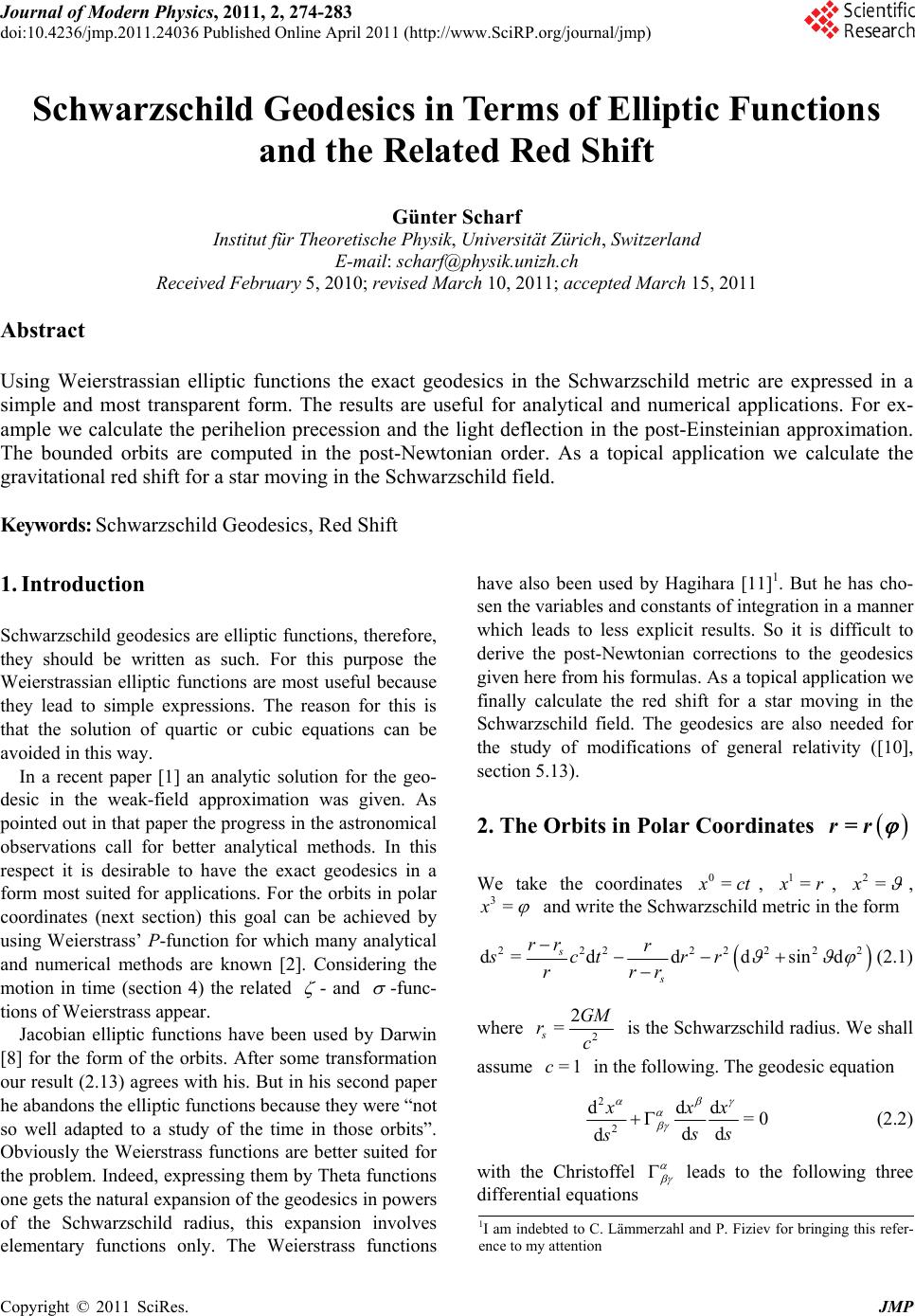 Journal of Modern Physics, 2011, 2, 274-283 doi:10.4236/jmp.2011.24036 Published Online April 2011 (http://www.SciRP.org/journal/jmp) Copyright © 2011 SciRes. JMP Schwarzschild Geodesics in Terms of Elliptic Functions and the Related Red Shift Günter Scharf Institut für Theoretische Physik, Universität Zürich, Switzerland E-mail: scharf@physik.unizh.ch Received February 5, 2010; revised March 10, 2011; accepted March 15, 2011 Abstract Using Weierstrassian elliptic functions the exact geodesics in the Schwarzschild metric are expressed in a simple and most transparent form. The results are useful for analytical and numerical applications. For ex- ample we calculate the perihelion precession and the light deflection in the post-Einsteinian approximation. The bounded orbits are computed in the post-Newtonian order. As a topical application we calculate the gravitational red shift for a star moving in the Schwarzschild field. Keywords: Schwarzschild Geodesics, Red Shift 1. Introduction Schwarzschild geodesics are elliptic functions, therefore, they should be written as such. For this purpose the Weierstrassian elliptic functions are most useful because they lead to simple expressions. The reason for this is that the solution of quartic or cubic equations can be avoided in this way. In a recent paper [1] an analytic solution for the geo- desic in the weak-field approximation was given. As pointed out in that paper the progress in the astronomical observations call for better analytical methods. In this respect it is desirable to have the exact geodesics in a form most suited for applications. For the orbits in polar coordinates (next section) this goal can be achieved by using Weierstrass’ P-function for which many analytical and numerical methods are known [2]. Considering the motion in time (section 4) the related - and -func- tions of Weierstrass appear. Jacobian elliptic functions have been used by Darwin [8] for the form of the orbits. After some transformation our result (2.13) agrees with his. But in his second paper he abandons the elliptic functions because they were “not so well adapted to a study of the time in those orbits”. Obviously the Weierstrass functions are better suited for the problem. Indeed, expressing them by Theta functions one gets the natural expansion of the geodesics in powers of the Schwarzschild radius, this expansion involves elementary functions only. The Weierstrass functions have also been used by Hagihara [11]1. But he has cho- sen the variables and constants of integration in a manner which leads to less explicit results. So it is difficult to derive the post-Newtonian corrections to the geodesics given here from his formulas. As a topical application we finally calculate the red shift for a star moving in the Schwarzschild field. The geodesics are also needed for the study of modifications of general relativity ([10], section 5.13). 2. The Orbits in Polar Coordinates =rr We take the coordinates 0= x ct , 1= x r, 2=x , 3=x and write the Schwarzschild metric in the form 222 2222 d=ddd sind s s rr r sct rr rrr 2 (2.1) where 2 2 = s GM rc is the Schwarzschild radius. We shall assume in the following. The geodesic equation =1c 2 2 ddd =0 dd d xxx ss s (2.2) with the Christoffel leads to the following three differential equations 1I am indebted to C. Lämmerzahl and P. Fiziev for bringing this refer- ence to my attention 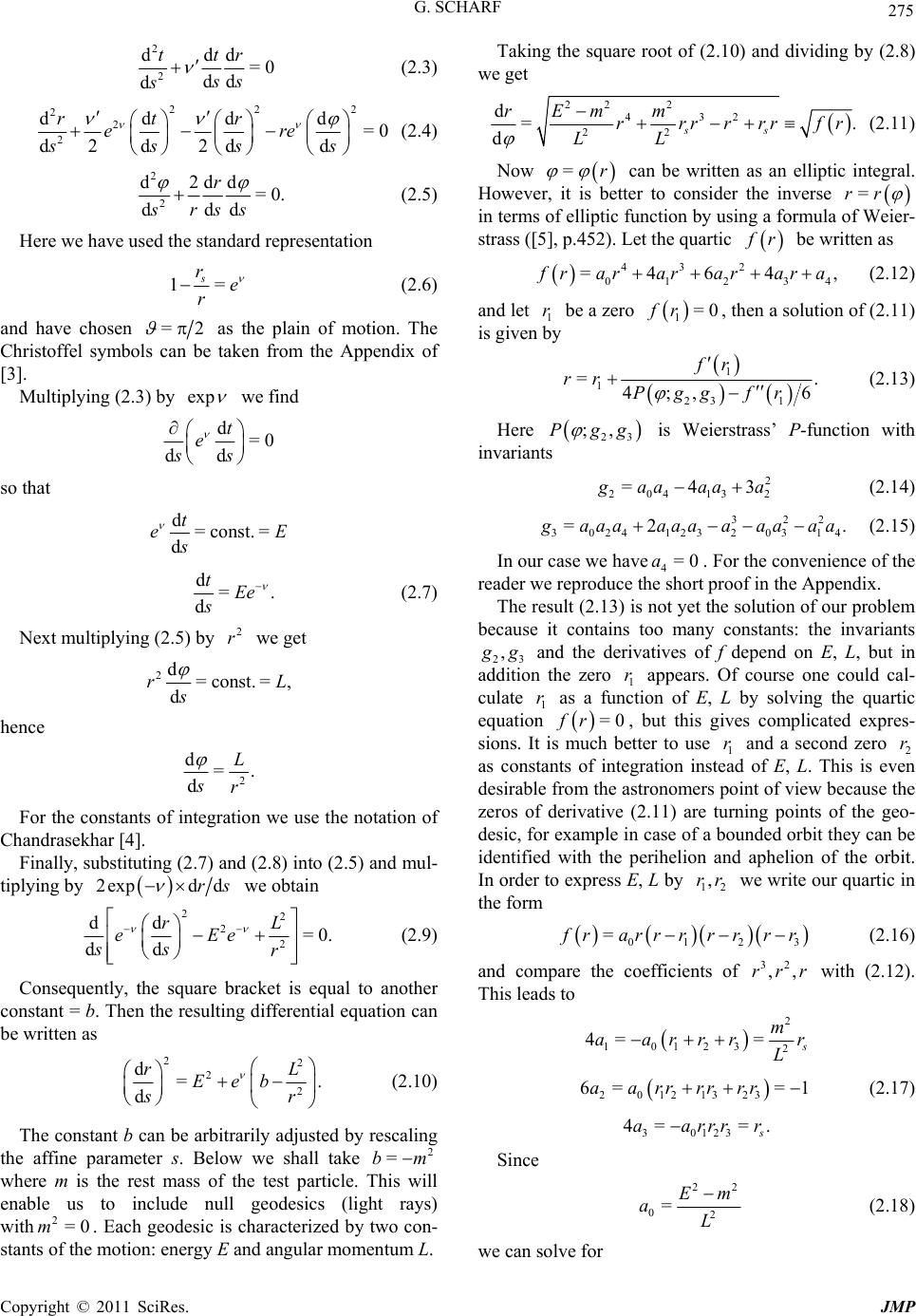 G. SCHARF 275 2 2 ddd =0 dd d ttr ss s (2.3) 22 2 2 2 2 dddd =0 2d 2dd d rtr ere ss s s (2.4) 2 2 d2dd =0. dd d r rss s (2.5) Here we have used the standard representation 1= s re r (2.6) and have chosen =2 as the plain of motion. The Christoffel symbols can be taken from the Appendix of [3]. Multiplying (2.3) by exp we find d=0 dd t e ss so that d=const.= d t eE s d= d tEe s. (2.7) Next multiplying (2.5) by we get 2 r 2d=const. =, d rL s hence 2 d=. d L sr For the constants of integration we use the notation of Chandrasekhar [4]. Finally, substituting (2.7) and (2.8) into (2.5) and mul- tiplying by 2expd drs we obtain 22 2 2 dd =0. dd rL eEe ss r (2.9) Consequently, the square bracket is equal to another constant = b. Then the resulting differential equation can be written as 22 2 2 d= d rL Eeb sr . (2.10) The constant b can be arbitrarily adjusted by rescaling the affine parameter s. Below we shall take 2 =bm where m is the rest mass of the test particle. This will enable us to include null geodesics (light rays) with . Each geodesic is characterized by two con- stants of the motion: energy E and angular momentum L. 2=0m Taking the square root of (2.10) and dividing by (2.8) we get 22 2 432 22 d=. dss rEm m rrrrrrf LL r (2.11) Now =r can be written as an elliptic integral. However, it is better to consider the inverse =rr in terms of elliptic function by using a formula of Weier- strass ([5], p.452). Let the quartic f r be written as 43 0123 =464frarararara 2 4 , (2.12) and let 1 be a zero r 1=0fr , then a solution of (2.11) is given by 1 1 23 1 =. 4;, 6 fr rr Pggfr (2.13) Here 23 ;,Pgg is Weierstrass’ P-function with invariants 2 204 13 =43 2 g aaaa a (2.14) 322 3024 12320314 =2 . g aaaaaa aaaaa (2.15) In our case we have4. For the convenience of the reader we reproduce the short proof in the Appendix. =0a The result (2.13) is not yet the solution of our problem because it contains too many constants: the invariants 23 , g g and the derivatives of f depend on E, L, but in addition the zero 1 appears. Of course one could cal- culate 1 as a function of E, L by solving the quartic equation r r fr=0, but this gives complicated expres- sions. It is much better to use 1 and a second zero 2 as constants of integration instead of E, L. This is even desirable from the astronomers point of view because the zeros of derivative (2.11) are turning points of the geo- desic, for example in case of a bounded orbit they can be identified with the perihelion and aphelion of the orbit. In order to express E, L by we write our quartic in the form r 2 rr r 1 , 012 = 3 f rarrrrrrr (2.16) and compare the coefficients of with (2.12). This leads to 32 ,,rrr 2 10123 2 4= = s m aarrrL r 20121323 6= =1aarrrrr r . (2.17) 30123 4= = s aarrrr Since 22 02 =Em aL (2.18) we can solve for Copyright © 2011 SciRes. JMP  276 G. SCHARF 2 123 2 12 1323 = s rrr mrrrrr rr L , (2.19) 2 22 123 =. (2.20) s mr Em rrr In addition we obtain the third zero 12 3 12 12 = s. s s rr rr rrrrr r (2.21) The relations (2.19-21) allow to express everything in terms of . For the invariants we find 12 ,rr 2 2123 22 12 13 23 11 == 1212 4 4 s s rrrr m gr rrrrr r L (2.22) 2 22 0 332 2 123 3 12 132312 1323 1 =16 648 11 1 = 48 16 6 ss ss a m grr L rrrr r rrrr rrrr rr rr . (2.23) Here has to be substituted by (2.21). For the deriva- tives 3 r 1 f r , 1 f r which appear in our solution (2.13) we obtain 11213 1 12 1323 =rr rr r fr rr rr rr (2.24) 12131 1213 1 12 1323 =2 . rrrrr rrrr fr rrrr rr (2.25) With these substitutions the result (2.13) gives all possi- ble geodesics in the form . This will be discussed in the next section. 12 =;,rr rr As a first check of the solution (2.13) we consider the Newtonian limit. Let the two zeros 1, 2 be real and large compared to the Schwarzschild radius r r s r in abso- lute value. Then neglecting s Or in the invariants (2.22-23) the P-function becomes elementary ([2], p.652, equation 18.12.27): 3 2 11111 ;,6== 1212122 1cos 4sin 2 P . (2.26) The leading order in the derivatives of f is given by 1 11 2 =r 2 f rr r r 1 1 2 =232. r fr r (2.27) It is convenient to introduce the eccentricity by 1 2 1 = 1 r r Using all this in (2.13) we find the wellknown conic 1 1 = 1cos r r . (2.29) Assuming both zeros 12 positive and 12 we have ,rr <rr <1 and the orbit is an ellipse with perihelion 1 and aphelion 2. In the hyperbolic case r r>1 we see from (2.28) that if 1 is positive 2 must be negative. Then there is only one physical turning point 1 which is the point of closest approach. The latter always corre- sponds to r r r =0 . The relativistic corrections to (2.29) are calculated in the following section. 3. Discussion of the Solution The solution =rr (2.13) is an elliptic function of which implies that it is doubly-periodic ([2], p.629 or any book on elliptic functions). The values of the two half-periods , depend on the three roots of the fundamental cubic equation 3 23 4egeg=0. (3.1) Again it is not necessary to solve this equation because the solutions can be easily obtained from the roots 12 0, of our quartic . To see this we transform ,=1,2,3 j ej 3 , ,rrr =0fr f r to Weierstrass' normal form as follows. First we set =1rx so that from (2.16) we get 32 321 4 1 =4 640 f raxaxax xa Next we remove the quadratic term by introducing 2 3 11 == . 2 a xe ra (3.2) This gives the normal form of Weierstrass 2 3 3 23 4 12 2 =4 a , f rege ea g (3.3) with the above invariants (2.14-15). That means roots of f r are simply related to roots of (3.1) by the trans- formation 321 == 24 12 s j jj ar a err . 2 3 (3.4) The cubic equation (3.1) with real coefficients has ei- ther three real roots or one real and two complex conju- gated roots. The first case occurs if the discriminant 3 2 =27 g g (3.5) is positive, in the second case is negative. In terms of the roots is given by ([2], p.629, equation 18.1.8) . (2.28) 22 2 1223 31 =16 .eeeeee (3.6) Copyright © 2011 SciRes. JMP  G. SCHARF Copyright © 2011 SciRes. JMP 277 The physically interesting orbits correspond case of real roots. If we have two complex conjugated ze where 2 K k is the complete elliptic integral of the first kind with parameter to the first ros * 21 =rr then (2.28) implies that the eccentricity is imaginary. Such orbits have been discussed by Chandar ([4], p.111). Now we discuss the various ses. 3.1. Bo 223 21 13 1212 1 1 == 2 23 =1 . 11 s s s s ee rr kr eerrrrr rr r (3.10) rasekh ca und Orbits ve two positive turning points , consequently there are three real roots As a first application let us give the post-Einsteinian correction to the orbital precession. If (3.10) is small we can use the expansion ([2], p.591, equation 17.3.11) 2 k In this case we ha 21 23 >0> >eee given by >>0rr 1 12 11 == 412 ss rr 1 31 2 64 rr er rr (3.7) 22 22 π113 =1 22 24 Kkk k 4 (3.11) 23 12 11 =,= , r (3.8) 12 412 4 ss r ee rr Our convention is chosen in agreement with half-period From the roots we find 13 ,ee [2]. The real of the P-function is given by ([2], p.549, equation 18.9.8) 2 23 12 12 12 12 13 22 13 =2 1. 28 s ss rrrrr rO rr rr ee r 1 3 13 23 = 4 e 2 d = K k t ee tg tg (3.9) This finally leads to the half-period 22 2 23 12 12 2121 222 12 11 12 33 331318 =π122=π1 482118 81 ss ss s rr rr rr rrrrrrOr rrr r rr (3.12) The perihelion precession is given by =2 π . hen the orderT s r in (3.12) is Einstein's result and the 2 s Or gives the correction to it. The acc- tion of the half-piod is necessary to control the orbit in e. To compute the relativistic corrections for urate computa er the larg r from (2.13) we express the P-function by Theta fu ([ (3.13) Here is the so-called Nome ([2], eq. 17.3.21) nctions 5], p.464) 1/426 1,=2sinsin 3sin 5zqqzqz qz 1/426 2 38 3 38 4 ,= 2coscos3cos5 ,=12cos 2cos 4cos6 ,= 12cos 2cos 4cos 6. zqqz qz qz zqqz qzqz zqqz qz qz q 2 22 =8 kk q (3. 16 16 14) These series are rapidly converging s (3.10), they give the natural expansion in powers of the Schwarzschild radius s r. Now the P-function is given in terms of Theta functions by ([2], eq. 18.10.5) 31 2 2 2 22 1 0 4 1π1 =1 41, cos 12 44sin s rqO q r (3.15) where 2 2 13 22 0 π =Pe π =. 2 (3.16) Using 2 11 2 1 3 =2 11 s r fr rr 2 12 1 15 14 =26 11 s r fr r ince 2 k is small (3.17) this leads to 2 2 12sin 1 fr r 12 2 1 1 3 =1 31cos2sin. 241cos 221 41 sin s s r P O rr (3.18)  278 Substituting this into (2.13) gives the desired orbit to G. SCHARF s Or 2 2 11 1c os2 1cos21crr 12sin1 33 =31cos2sin. os2 211 s rr (3.19) It is important to insert the period in (3.16) according to (3.12) in order to describe the perihelion recession correctly. . If all three zeros coincide p If the two roots 12 =rr coincide, it follows from (2.24) that 1=0fr . According to (2.13) we then have circular motion =r1 r ) giv 123 ==rr then (2.21es 3=3r s rr which is the innermost ct. und Orbits ircular orbi 3.2. Unbo this case there is only one physical point, the point of he other root is negative, erefore, it is to use the eccentricity In closest approach 1 r. T2 r th better (2.27) as the second basic quantity. With 3 r given by (2.21) we then have 13 21 1 >>0>=, 1 rr rr (3.20) because 1 . The periodicity of (2.13) in is now realized jump to an unphysical br In moves on one branch only by a reality a comet blem anch with <0r. , bu . t it is a in the tricky pro to decide on which one. This is due to the fact that the period differs a little from 2π as bounded case. Consequently, neighboring physical branches >0r are a little rotated against each other and the distinction between them is not easThe quan- tity of physical interest is the direction y of the as- ymptote. Iows from the original equation (2.11) by integrating the inverse over r from 1 r to t foll 1 d =. r r f r (3.21) This is an elliptic integral which Legendre’s normal form can be transformed to 2 0 0 d =a 22 1s ink (3.22) by the transformation ([6], vol.II, p.308) 22 32 32 1 2 12 31 rr rr rr 2 sin=, sin=. rr rr rr (3.23) The parameter in (3.22) is given by 2 k 2312 13 2 rr r 13 2 2 = rr r . The integral (3.22) is an incomplete elliptic integral of the first kind (3.25) 2 2 0 =, F k a (3.26) which has the expansion ([6], vol.II, p.313) 2 24 222 2 1 ,=sin2 . k 42 F kOk (3.27) For small 1s rr we find 2 2 1 1 1s r 2 =s r kOrr 2 1 1 0 3 =2 1 s s rOrr r a 23 2 1 1 sin =1. 2 r r This gives 3 2 1 11 cos 2=r r and 22 1 3 =2sin2 . 122 s r r 2 (3.28) It is convenient to calculate 2 2 2 1 11 1 cos =3. 21 s s rOr r (3.29) The leading order is the Newtonian asymptot hyperbola. For there is only one constant of integrat th .11) e of the 3.3. Null Geodesics 2=0m e quartic (2 ion in 4 2 2 = s r f rrrr d pact parameter =, rrr k (3.24) and which is the so-called im =. L dE (3.30) Copyright © 2011 SciRes. JMP 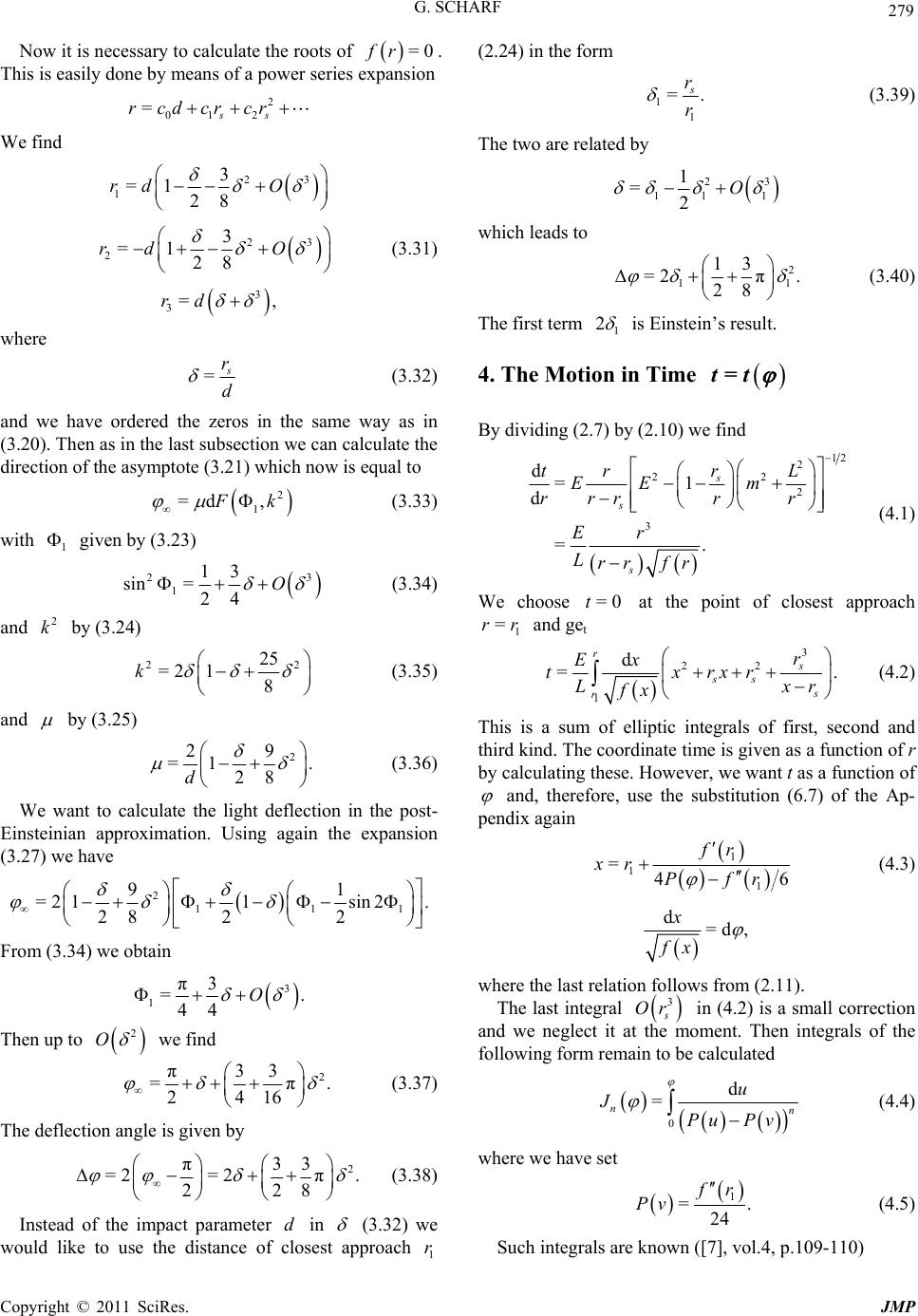 G. SCHARF 279 ry to calculate the roots of Now it is necessa =0fr es expansion . This is easily done by means of a power seri 2 01 2 =ss rcdcrcr We find 23 O 1 3 =1 28 rd 23 2 3 =1 28 rdO (3.31) 3 3=,rd where = s r d (3.32) and we have ordered the zeros in the sam (3.20). Then as in the last subsection we can calcu direction of the asymptote (3.21) whih now is equal to e way as in late the c 2 1 =d , F k (3.33) with given by (3.23) 1 23 1 sin =24 O 13 (3.34) and 2 k by (3.24) 22 25 =2 18 k (3.35) and by (3.25) 2 29 =1 28d . e want to calculate the light deflection in the post- Einsteinian approximation. Using again (3.27) we have (3.36) W the expansion 2 9 1 11 1 1 =21sin2 . 28 22 From (3.34) we obtain 3 1 π3 =. 44 O Then up to O 2 we find 2 π33 =π. 2416 (3.37 ven by ) The deflection angle is gi 2 π33 =2 =2π. 228 (3.38) f the ieter in Instead ompact paramd (3.32) we would like to use the distance osest approach (2.24) in the form of cl 1 r 1 1 =. s r (3.39) The two are related by r 23 11 21 1 =O which leads to 2 11 28 13 =2 π. (3.40) The first term 1 2 is Einstein’s result. 4. The Motion in Time =tt by (2.10) we find By dividing (2.7) 12 2 22 2 d=1 d =. s s r tr L EE m rrrrr 3 Er s Lrr fr (4.1) e choose at the point of closest approach W=0t 1 =rr and get 3 22 1 d =. r s ss s r r Ex txrxr Lx fx r (4.2) This is a sum of elliptic integrals of first, sec third kind. The coordinate time is given as a function of r by calculating these. However, we want t as a function of ond and and, therefuse the substitution (6.7) of the Ap- px again ore, endi 1 1 1 =4 fr xr Pfr 6 (4.3) d=d , x fx where the last relation follows from (2.11). The last integral 3 s Or in (4.2) is a small correction and we neglect it oment. Then integrals of the following form remain to be calculated at the m 0 d = nn u J Pu Pv (4.4) where we have set 1. 24 = f r Pv (4.5) Such integrals are known ([7], vol.4, p.109-110) Copyright © 2011 SciRes. JMP 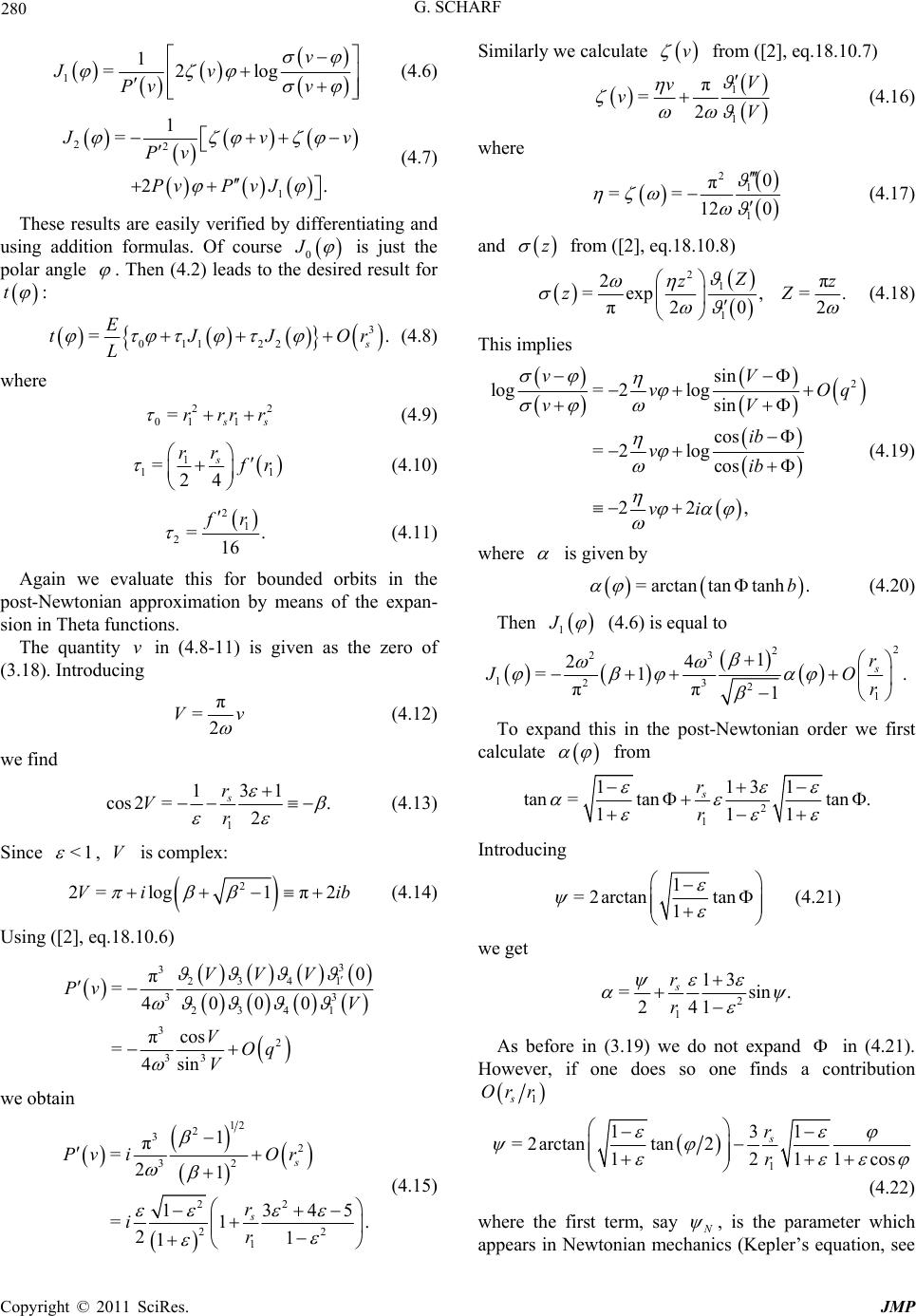 280 G. SCHARF 1=2logJv Pv v 1v (4.6) 2 1 = 2 2 1. J vv v PvP vJ (4.7) These results are easily verified by differentiating and us P ing addition formulas. Of course 0 J is just the polar angle . Then (4.2) leads to result for the desired t : 3 011 22 =. s E tJJ L Or (4.8) where 22 011 = s s rrrr (4.9) 1 11 =24 s r r f r (4.10) 2 1 2=. 16 f r (4.11) Again we evaluate this for bounded orbits tonian approximation by means of the expan- sion in Theta functions. The quantity in (4.8-11) is (3.18). Introducing in the post-New v given as the zero of π =2 Vv (4.12) we find 1 131 cos 2=. 2 s r Vr (4.13) Since <1 , V is complex: 2 2= loVi g1π2ib (4.14) Using ([2], eq.18.10.6) 3 3 2341 33 2341 3 2 33 0 π =4000 πcos =4sin VVV Pv V VOq V we obtain 12 2 3 2 3 =2 Pvi v from ([2], eq.18.10.7) 2 22 22 1 1 π 1 1345 =1 . 21 1 s s Or r ir (4.15) Similarly we calculate 1 1 π =2 V v vV (4.16) where 2 1 1 0 π == 12 0 (4.17) and z from ([2], eq.18.10.8) 2 1 1 2π =exp, = π20 2 Z zz zZ . (4.18) This implies 2 sin log=2logsin cos =2 log cos 22, vV vO vV ib vib vi (4.19) e q wher is given by = arctantantanh.b Then (4.20) 1 J (4.6) is equal to 2 2 23 123 21 1 2 4 =1 . ππ 1 s r JO r To expand this in the post-Newtonian order we first calculate from 2 1 1131 tan=tantan . 11 1 s r r Introdug cin 1 =2arctantan 1 (4 we get .21) 2 1 13 =s 24 1 s r r in. As before in (3.19) we do not expand in (4.21). However, if ne does oso one finds aribution cont 1s Or r 1 131 = 2arctan tan 2 1211cos s r r (4.22) where the first term, say N , is the parameter which appears in Newtonian mics (Kepler’s equation, see echan Copyright © 2011 SciRes. JMP  G. SCHARF Copyright © 2011 SciRes. JMP 281 .29)). Now the expansion of 1 J below (4is given by which also follows directly from the definition (4.4). To expand 01 11 1 =s r JJ J r 1 0 1 11 =2 1 J (4.23) 1 121 2. 2 1131 =73 sin 1 1543 J 11 For 0 we have the simple finite limit 22 1 01 22 1 1 =2 πsin2 cos 2 =s JP Pv PvJ r JJ r v we need 22 2 2 1 =6 2 2111 185 =1 22211 1 s g Pv Pv r r . 1=0 1 2 =132sin 2 π s r Jr This finally leads to 00 21 sin2 42)1 =11cos221 JJ 2 11 (4.25) 222 1 22 23 01 11 2 1 2151211sin2143171312 =11cos21cos2 1 615812 . 1 11 J JJ 2 1 (4.26) ain wAge do not expand (3.16) in order to keep the perihelion precesble. The limit for sion as precise as possi 0 is equal to 2=0 1 =21664sin 2sin 2cos 2. s r Jr In the final result (4.8) for the time 01 1 =s r tt t r (4.27) the pre-factor EL also gives a correction: 11 11 s 2 =1 s r E Lrr r which follows from (2.19-21). Inthe terms propor- tional to 0 t cancel 3 1 02 21si =. 11 1cos2 1 s r tr n2 (4.28) Approximating by this is in agreement with 2 Kepler’s equation 3 1 03 2 =s 1 s r t r in. (4.29) The post-Newtonian corrections in (4.27) come from various places. To show this we write the result in the form 3 101 1 101 1 2 2 23 2 2115 3 0 . 11 1 22 41 11 s r tJJ JJ r =t (4.30) As in (3.19) the post-Newtonian correction vanishes for circular motion =0 . 5. Gravitational Red Shift chwant for the investigation of the recently discovered S-stars near the Galactic Center ([1] and references given there). These stars move in the strong gravitational field of the central black hole so that general relativistic effects are observ- able and the Schwarzschild metric g easurabl is a fairly good description of the situation. The me quantity of interest is the red shift of spectral lines in the light emit- ted by the moving star. Therefore we finally consider The study of Sarzschild geodesics is relev  282 G. SCHARF this. Let 1 n be the frequency of a given atomic line from the star ad 0 the frequency of the same line observed in the frame of the galaxy. If rest dd x t is the v of the two frequencies are related by ([9] equ elocity p.83, star, the . 3.5.6) 1/2 1 1/2 000 dd dd =. xx gxtt gX (5.1) We assume that the observer at X is far away from the ce in thelane nter such that the denominator can be approximated by 1. For a star moving p=π2 we have 22 2 dd d = dd d xx gx ee tt d. d rr t t (5.2) From (2.10) and (2.7) we find 2 2 22 d=1 d reL em tEr and (2.8) gives 2 d=. d Le tE r Substituting all this into (5.1) we see that L drops out and we endp with the simple result u 1 0 ==1 . r mm e EEr (5.3) By (2.20) s we can express E by the perihelion and aphelion 1 r 2 r 22 123 =1 s r Em rrr w here 3 r is the small correction (2.21). Then we finally get 1/2 1ss rr 01 23 =1 1. rr rr (5.4) The lowest order s Or is equal to 2 1 012 =1 . 2 ss s rr Or rr r (5.5) Since the last term is always smaller than the second one we indeed have red shift 10 > . 1 =rr Of course, mal at the perihelion where is minimal. The total ob to the star ([9], p.30). 6. Acknowledgments It is a pleasure to acknowledge elucidating with Prasenjit Saha, in particular the introduction into the fascinating field of Galactic-center stars. I also thank Raymond Angélil for showing his simu corresponding dynamics. [1] D. J. D’Orazio and P. Saha, “An Analytic Solution for Weak-field Schwarzschild Geodesics,”ly Notices of the Royal Astronomical Society, Vol. 406, pp. . Stegun, “Handbook of Mathe- s,” Dover Publications, Inc., New York. [3] G. Scharf and Gen. Relativ. Gravit, “From Mass ity to Modified General Relativity,” General and Gravitation, Vol. 42, pp. 471-487. 14-00 it is maxi- served red shift is obtained by multiplying (5.5) with the Doppler factor 1 1r v where r v is the compo- nent of the relative velocity along the direction from the observer discussions lations of the 7. References Month 2787-2792. [2] M. Abramowitz and I. A matical Function ive Grav- Relativity doi: 10.1007/s1079-0864-0 [4] S. Chandrasekhar, “The Mathematical Theory of Black Holes,” Oxford/New York, Clarendon Press/ versity Press, 1983. er Tr lli n and Cosmology,” John Wiley, Oxford Uni- [5] E. T. Whittaker and G. N. Watson, “A Course of Modern Analysis,” Cambridge University Press, 1950. [6] A. Erdelyi et al., “Highanscendental Functions,” McGraw-Hill Book Co., Inc., New York, 1953. [7] J. Tannery, J. Molk, “Fonctions eptiques,” Chelsea Publishing Company, Bronx, New York , 1972. [8] Ch. Darwin, Proc. Roy. S. London A 249 (1959) 180, A 263 (1961) 39. [9] S. Weinberg, “Gravitatio New York, 1972. [10] G. Scharf, “Quantum Gauge Theories-Spin One and Two,” Google-Books (2010) free access. [11] Y. Hagihara, Japanese J. Astron. Geophys. 8 (1930) 68. Copyright © 2011 SciRes. JMP 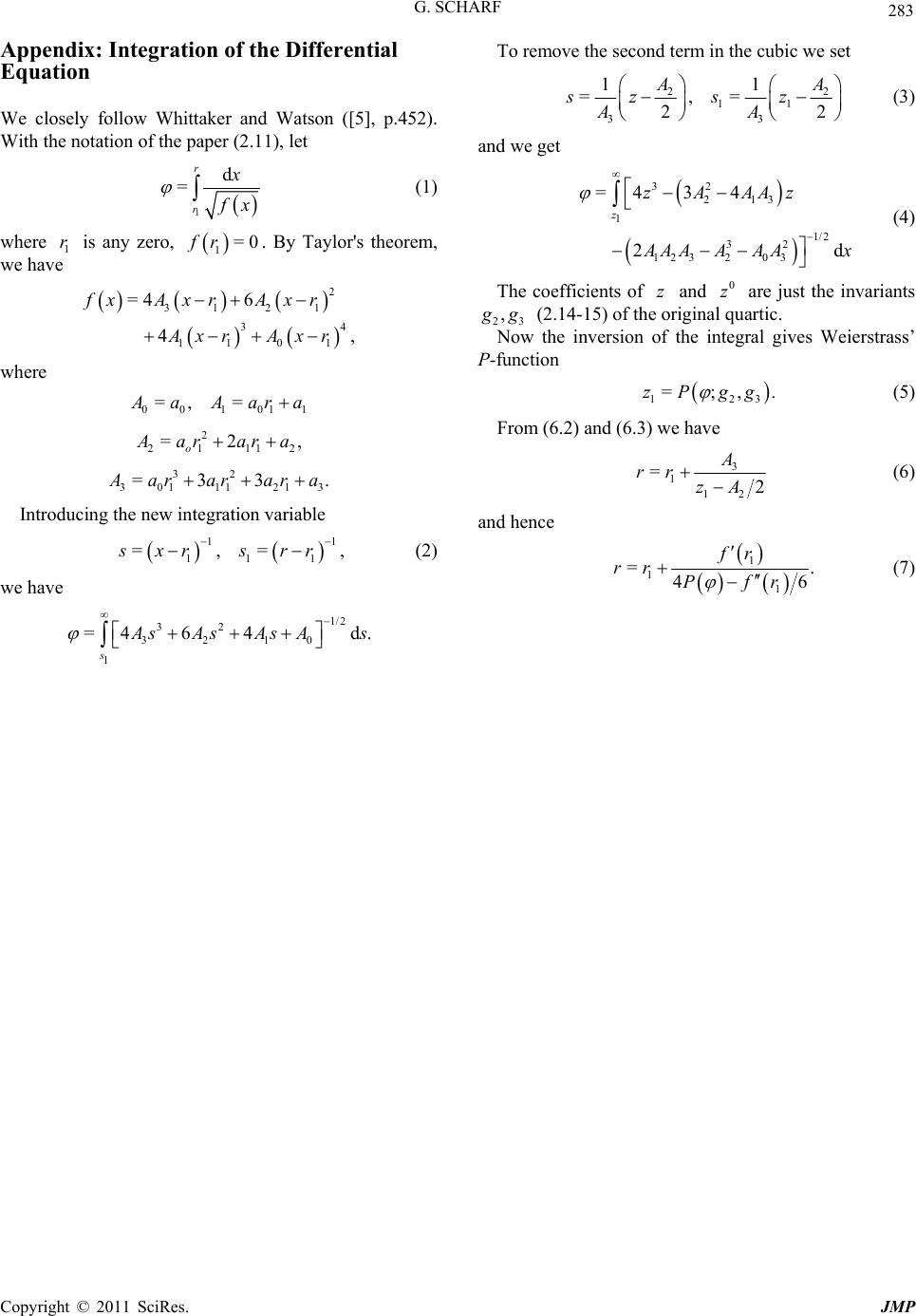 G. SCHARF 283 on ([5], p.452). ), let Appendix: Integration of the Differential Equation We closely follow Whittaker and Wats With the notation of the paper (2.11 1 d = r r x f x (1) where 1 r is any zero, 1=0fr . By Taylor's theorem, we have 2 31 21 =4 6fxAxrAxr 34 11 01 4, A xr Axr where 100 101 =, = A aAara 2 2111 =2 o2 , A arara 32 301 11213 =33 . A ararar a Introducing the new integration variable , (2) we have . 11 11 1 =,=sxrs rr 1/2 32 3210 1 =4 64d s A sAsAsA To remove the second term in the cubic we set 22 11 3 11 =,= 3 22 A A szsz A (3) A and we get 32 2 1 1/ 1 3 =434 z zAAAz 2 32 123 203 2d A AA AAAx (4) The coefficients of and are just the invariants z0 z 23 , g g No (2.14-15) of grtic. w the inversion the igral gives Weierstrass’ P-function 3 . (5) From (6.2) and (6.3) we have the ori of inal qua nte 12 =;,zP gg 3 1 12 =2 A rr zA (6) and hence 1 1 1 =. 46 fr rr Pfr s (7) Copyright © 2011 SciRes. JMP |

